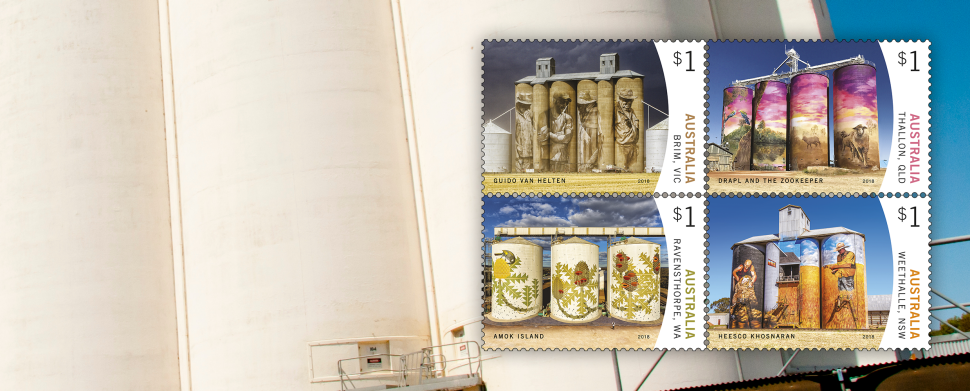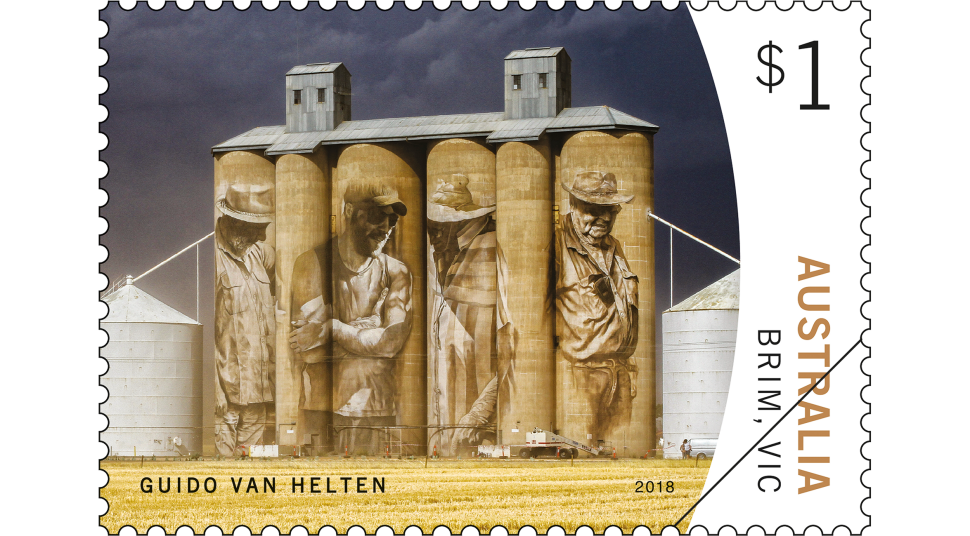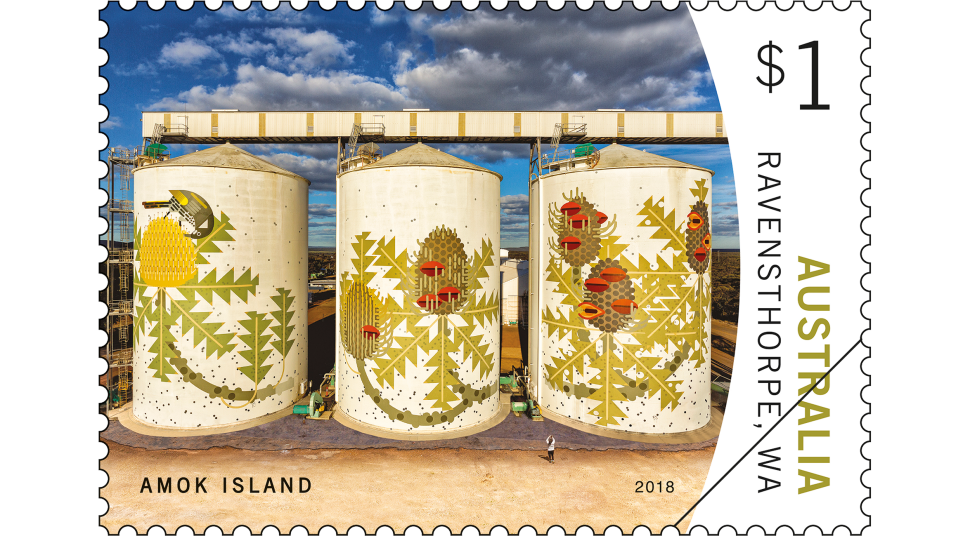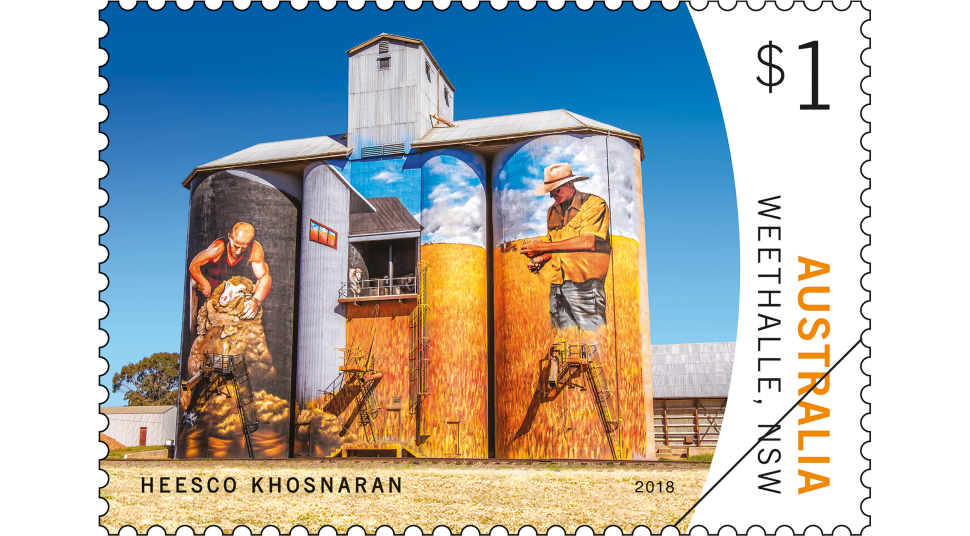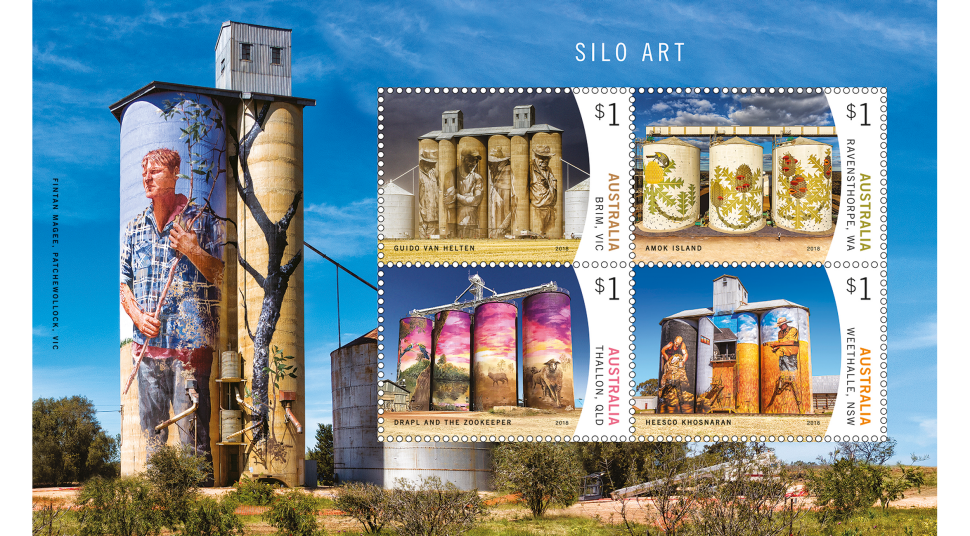In the last few years some extraordinary artworks have appeared across Australia. The unlikely canvases for these works are the towering grain silos that dominate numerous small wheat-growing country towns. Many of these proud and tight-knit communities are suffering from a range of issues including drought and population attrition. The remarkable painted silos have revitalised these tiny towns, putting them firmly on the national and international map. The landmark edifices, painted by renowned street artists, are attracting an increasing number of visitors who travel long distances to view the breathtaking, monumental murals that depict the local people, history and natural environment.
Australia’s first silo mural was painted at Northam, Western Australia in 2015. Three more have since followed in the west, the most recent completed in March 2018 at Albany Port. Together they comprise FORM’s PUBLIC Silo Trail. Victoria’s Wimmera-Mallee region is home to the six silos of the Silo Art Trail. The first of these was painted at Brim in the summer of 2015–16. Other silos have been painted in South Australia, New South Wales, Queensland and Victoria and several more are in the planning stages.
The Silo Art stamp issue, designed by Janet Boschen Design and released on 21 May 2018, features four examples of silo art from across the country.
Guido van Helten, Brim, Vic
The little town of Brim is situated on the banks of the Yarriambiack Creek in Victoria’s wheat-growing Wimmera region, some 350 kilometres north-west of Melbourne. The 30 metre high silo murals were an initiative of artist Guido van Helten, silo owner GrainCorp, and local community organisation the Brim Active Group. This was the first silo mural in eastern Australia. Its huge success as a tourist attraction encouraged the Yarriambiack Shire to commission five additional GrainCorp silo murals. These six silos now constitute the Wimmera-Mallee Silo Art Trail.
Before he began painting the silos, Brisbane-based Guido van Helten spent around a week getting to know the community and the local people. Four monumental figures comprise the silo mural. The three men and one woman of different ages, hats shading their faces from the fierce midday sun, seem to grow from the dusty Wimmera soil itself. Van Helten painted the mural across one side of the six silos during a three week period in the summer of 2015–16. He used spray paint and acrylic exterior paint, which he applied from high on a cherry picker. His style is highly realistic; he often paints from photographs and is inspired by the tradition of documentary style humanist street photography. In 2016, the Brim Silo Art Project, based on the monumental Brim murals, was a finalist in the prestigious national Sir John Sulman Prize.
Guido van Helten is among the world’s most prominent public mural artists. His characteristically realist, monochrome portraits can be found on buildings in Ukraine, Poland, Spain, Belarus, Finland, Italy, USA and elsewhere. There is a strong political element to much of van Helten’s art and he is willing to risk his own safety to complete a project. In 2017, the 30th anniversary of the Chernobyl nuclear disaster, van Helten honoured the memory of photojournalist Igor Kostin with a portrait painted inside an abandoned nuclear reactor at the still prohibited, radiation-affected site.
Drapl and The Zookeeper, Thallon, Qld
The town of Thallon is located in South West Queensland, 571 kilometres west of Brisbane. Built in the 1970s, the 300,000 tonne GrainCorp depot is one of the largest in Australia. Despite recent near-record harvests, Thallon township has suffered through drought and the cessation of rail services, leading to a decline in businesses and population.
The plan to paint four of Thallon’s 30 metre high, 40 metre wide silos was a co-initiative of the Thallon Progress Association, owners GrainCorp and the two Brisbane-based artists, Drapl and The Zookeeper. The Thallon community was closely involved with the development of the design. The two artists met Thallon residents over beers at the local hotel and shared stories about the town. The locals also brought along photographs illustrating what the region means to them. From this meeting evolved the final artwork, The Watering Hole, which depicts aspects of Thallon, including the spectacular sunsets and the picturesque Moonie River. Photographs by three locals inspired the beautiful images: Chantel McAlister’s First Light, Lila Brosnan’s The Moonie River and Gary Petrie’s photo of two Pale-headed Rosellas. The mural also includes a scarred tree, acknowledging the community’s Indigenous history and sheep, referencing the wool industry. At the launch of the silo project, the two artists were presented with Thallon’s traditional “keys to the city”, bottles of water from the Moonie River. Locals say that once you’ve tasted water from the river, you’ll be sure to return.
The giant mural occupied the artists for three weeks, working 10 hours a day. Guided only by an A4-size impression, Drapl and The Zookeeper executed the painterly artwork with 500 litres of paint and 500 spray cans.
Amok Island, Ravensthorpe, WA
The Western Australia town of Ravensthorpe lies in the southern Goldfields-Esperance region, 541 kilometres east of Perth and 40 kilometres inland from the southern coast.
The Ravensthorpe silo murals were the second after the Northam silo murals to be commissioned by the FORM agency for the silos’ owners, the CBH Group. The project took 31 days to complete, using 338 litres of paint, and the work was carried out by Fremantle-based artist Amok Island in a boom lift. Like most silo artists, Amok Island selected imagery of particular relevance to the local region. His work, Six Stages of Banksia baxteri, depicts flora and fauna of the Ravensthorpe area, including an endemic banksia and the species’ main pollinators, the tiny Honey Possum, found only in the southwest of Western Australia, and the black, yellow and white New Holland Honeyeater, which is found throughout southern Australia. Each side of the three silos shows a different stage in the flowering cycle of the banksia, from bud to bloom to formation of seedpods and release of the seeds. Both sides of the three-cylinder silo bank have been employed to illustrate the never-ending cycle of the seasons, of crucial importance to all growing plants, including wheat and other grains produced in the region and stored in the silos.
Heesco Khosnaran, Weethalle, NSW
Weethalle is a small town in the Central West region of New South Wales.
The Weethalle silo was the first to be painted in New South Wales. The initiative came from Bland Shire Council which, inspired by the success of Victoria’s silo trail, called for applications from artists Australia-wide to undertake the project. Nine artists applied and Mongolian-born Heesco Khosnaran was selected by a committee comprising Council and community representatives. They were impressed by Heesco’s undertaking to faithfully reflect the local community and its history. The community preferred that identifiable people were not represented in the artwork, so the artist drew his inspiration from several photographs to represent the district’s main agricultural activities: shearing and wheat growing. The muscly shearer grasping a merino sheep is based on a photograph by Millie Brown. To the right, on a brilliant sunny day a farmer surveys his golden crop of ripened wheat while a combine harvester works in the background. The intense palette of the mural was inspired by the artist’s perception of the town environs.
To execute the vast mural, which consumed 200 litres of house paint and 300 spray cans, Heesco worked from a 24 metre telescopic boom lift. He began the two week project by pressure washing nearly a century of dust and dirt on the silo walls before applying an undercoat. The large flat areas of colour were applied with a spray machine while the details were worked using a spray can.
Minisheet
The minisheet depicts the silos at Patchewollock, on Victoria’s Wimmera–Mallee Silo Art Trail. Painted in 2016 by Brisbane artist Fintan Magee, the 35 metre mural shows local farmer Nick Hulland.
Prestige booklet
A prestige booklet has been released with this issue. The booklet showcases these incredible artworks, the rural towns in which they sit, the talented artists who created them and the organisations that supported each project.
The Silo Art stamp issue is available from 21 May 2018, online, at participating Post Offices and via mail order on 1800 331 794, while stocks last.
View the gallery and technical details from this issue
This article was produced at the time of publication and will not be updated.
